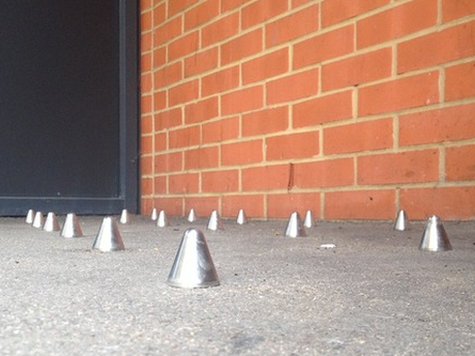
There’s no vagrancy where I live, but, if there were, I think I too would be tempted to install the “anti-homeless spikes” that have prompted such earnest pearl-clutching in the last few days. Personally, I don’t see what’s wrong with protecting the integrity of private property, despite what the fulminating spinsters of the Left-wing press might claim.
This row is partly over whether homeowners should be allowed to deter people from sleeping in the doorways of private residences, for the security and comfort of those who have paid large sums to live in nice neighbourhoods. It seems obvious to me that they should. But it’s also about how damaging manufactured outrage can be to those who ostensibly stand to benefit from it.
With squeals about reducing the unfortunate to the status of “vermin,” you’d think Government-appointed death squads had descended on the streets of London with Uzis to exterminate all the tramps. The truth is less exciting: there are a few studs outside a doorway in Southwark. Oh, and some on the windows of the Tesco on Regent Street, which have been there for ages.
London mayor Boris Johnson has proclaimed the studs “ugly, self-defeating and stupid.” He is right to note that this is a matter of aesthetics, but he reaches the wrong conclusion. The studs are more of a polite notice the area is not suitable for rough sleeping than a campaign of aggression against the poor. They’re an encouragement to seek shelter somewhere you can get food and medical care.
This being Britain, the studs–at least the ones I’ve gone to look at over the past few days–are nothing compared to those in Beijing or Paris, and can be quite easily triumphed over by determined insurgents with a few sheets of corrugated cardboard. Frankly I’ve had less comfortable orthopaedic mattresses.
Tesco says they are there to prevent unkempt youths and gadabouts from urinating and shooting up outside family businesses. It might put older customers off, says the supermarket. After all, they only came in for a pint of milk and a copy of the Radio Times and, who knows, they might be intimidated by tattooed thugs loitering near the cash points. This is perfectly respectable reasoning.
That so much outrage blossomed so abruptly, despite the existence of these studs for many years in London, tells us much about the opportunistic, viral mechanics of the internet, but little about how we should titivate our cities. Let’s remember that such devices, called “defensive architecture,” are generally only installed after repeat offences by druggies and drunks.
They’re not even that ugly, as Boris Johnson felt he needed to claim. Spikes and other ornamentations have been a practical mainstay of London’s architectural landscape for hundreds of years. Are we to remove them wherever they appear? Are the spikes on the Tower of London’s iron railings an affront to the dignity of would-be burglars?
Inspired by the near-future dystopias of mega-rich versus destitute in movies such as The Hunger Games, grievance mongers are getting into an unnecessary stew. They should chill out. There are no plans to introduce myxomatosis for itinerants, or gun down rough sleepers in cold blood, or banish anyone from the capital. This is not “social cleansing,” just good city hygiene.
The great unspoken truth about Britain’s supposedly runaway homeless problem is how many of its alleged victims live peripatetically on purpose–drug addicts evading the law and Left-wing malcontents who “reject society” and choose for themselves bizarre alternative lifestyles. Such people reject offers of shelter, and they deserve incarceration, not mild inconvenience. Yet asking them to choose a different property upon which to urinate is an indignity too far for touchy-feely modern sensibilities.
Aren’t these studs in fact a compassionate reaction to a problem with deep roots, often involving drug abuse and mental illness? Charities such as St Mungo’s Broadway already actively work with councils to “make the physical environment less comfortable” and encourage rough sleepers to come in from the cold to one of the many facilities available to them.
Society ought not go out of its way to make homelessness attractive, and is within its rights to stigmatize alternative lifestyles where they adversely affect the quality of life enjoyed by ordinary citizens–as in the case of drug addicts, thousands of whom get high on a daily basis at taxpayers’ expense. Purely for their own safety, do we want homeless people sleeping on freeways and under railway bridges? It feels like enabling self-destructive behaviour.
It is obviously discomforting to have a painful social problem thrust into view. And the medieval imagery doesn’t help. We associate spikes with torture and bloodshed from a period in our history many consider barbaric. We feel helpless–that our society is brutal and cruel, sliding back into cold, unfeeling plutocracy. We instinctively shudder at the thought of disadvantaged people impaled on brass and steel.
But the truth is that we would all be irritated beyond measure at a persistent rough sleeper, who has been warned to move on, continuing to trespass on and debase our property. It is not an outrageous thing to say so. Let’s face it: if you or I woke up to a smelly, obnoxious Occupy type monopolising our front porch for weeks on end, we’d do a lot worse than install a few brass studs in the floor.
So this private sector innovation should be taken up enthusiastically by councils, to help guide the guideless into shelters, kitchens and halfway houses–where they can be rehabilitated and turned into productive members of society. It is, counterintuitive as this may sound, the humane thing to do.
Read me at Business Insider on Fridays, on technology and media, and at Breitbart.com on Mondays, on U.K. politics. My first book, The Sociopaths of Silicon Valley, will be published in 2015.

COMMENTS
Please let us know if you're having issues with commenting.